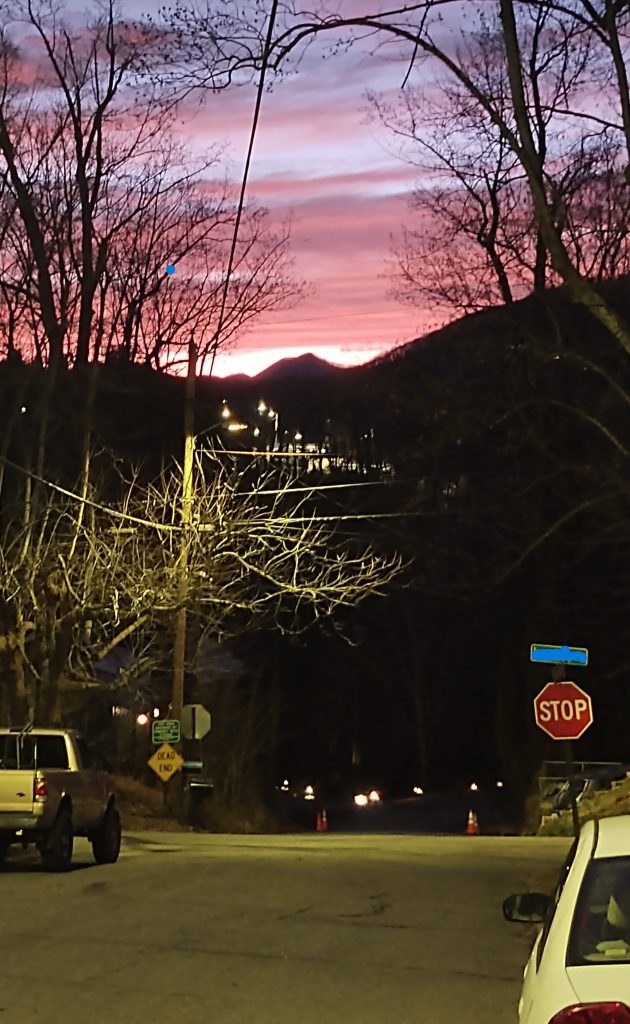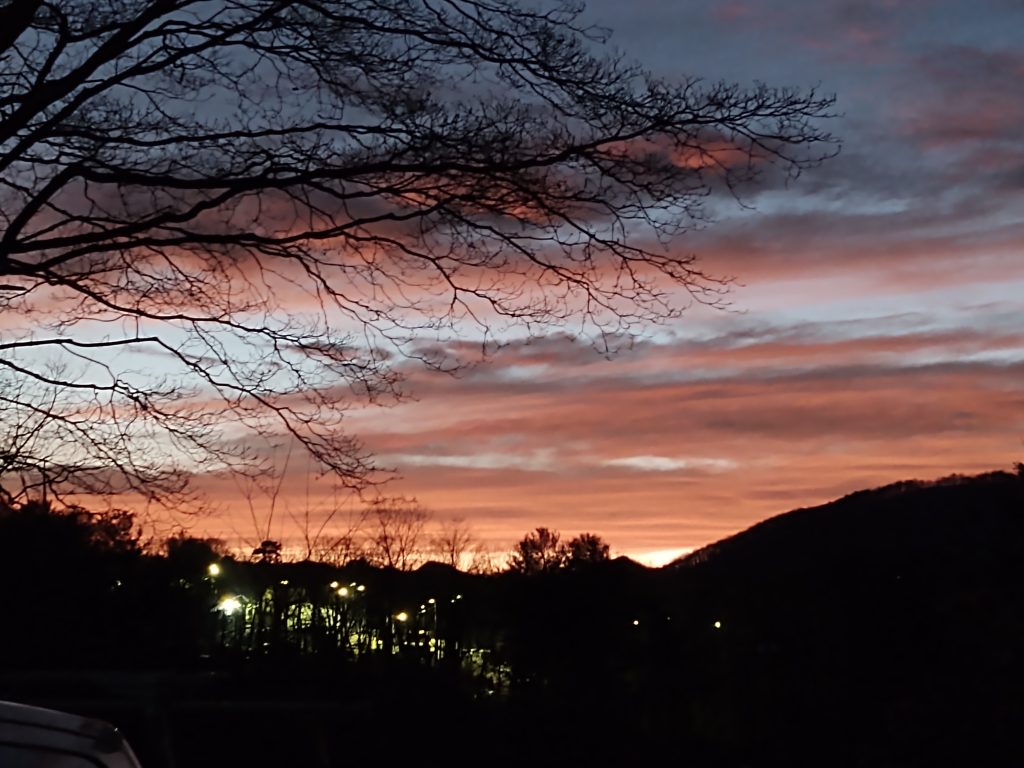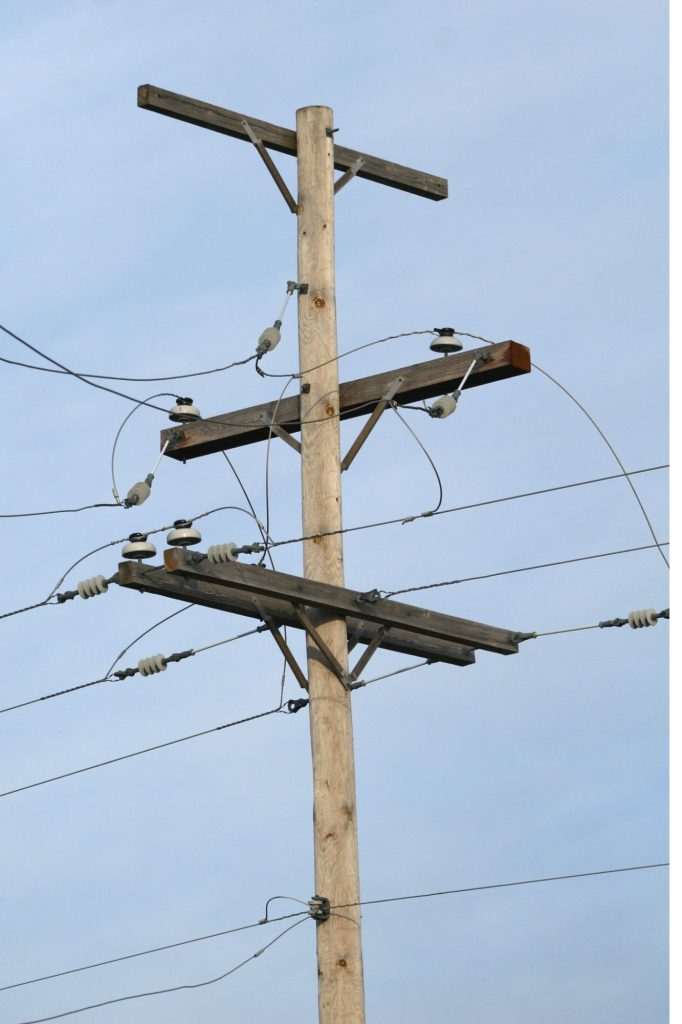~~~~~~~~~~~~~~~~~~~~~~~~~~~~~~~~~~~~~~~~

The glowMy sweet little neighborhood in West Asheville is turning 100 this year. I, for one, am ready to celebrate its long history. My house is the oldest I have ever lived in, having been built twenty years into the neighborhood’s existence. We three (me, man, dog) walk these blocks every day, noticing the goings on, greeting the neighbors and dodging other dogs. My dog, of course, is known as the troublemaker, though we have used a few strategic moves to avoid any unpleasant encounters whenever possible. At sunset, the sun goes down over the mountain peaks to the west, often with a pink/orange glow. Some seasons we catch a glimpse of the swifts returning to the chimney of a local building on the main road. It feels to us like Apple Pie Americana, but there is some quirkiness here, as befits a neighborhood in fun and funky West Asheville.
Everyone in Asheville and surrounding areas has a few tales to tell about their local wildlife. We have had a good share of stories just in the few short years we’ve lived here. The most recent and controversial subject of conversation has been about Sparky the Squirrel. You may have guessed by his name that Sparky met a most unfortunate demise. He was electrocuted on the power lines above the street last September. The thing is though, upon the occasion of his tragic passing, he held on to the instrument of his execution with, well, a death grip…for months. That electrocuted squirrel carcass eventually let go of the line with one paw and hung tenaciously above our street by the other, rotting on the vine so to speak, for six months. He only just recently lost his lofty position on a particularly windy day and the details surrounding the consequent removal of his desiccated cadaver are currently a mystery.

Crow familyIn other animal lore, Bob, our local gardening guru, began feeding crows with some feed in his backyard. One crow in particular made himself known by his distinctive limp. He was dubbed Limpy, and his benefactor would leave dog kibble on the front steps of his property to attract this easily-identified bird. Limpy would grab the kibble and fly off to another yard to dig holes to bury it. He often dropped some in the rain gutter of the house next door. Perhaps this was his stashing-for-a-rainy-day strategy. Limpy soon appeared with what looked like his crow family, eager for the easy pickings. Often he would grab all the kibble and fly off to share it with them, which might be a bit of conjecture, but Limpy was certainly the patriarch of the flock. He would sometimes perch on a certain pole to watch the doings of his brood. No other crow challenged him for his high seat above the feeding grounds. Limpy has not been seen in the hood lately, so there is some belief that he may have joined Sparky in some other greener pastures. However, another crow has been spotted roosting on Limpy’s former throne, perhaps the offspring of Limpy, with similar ruling aspirations.
Being a gardener in Asheville can be tricky when dealing with free-roaming wildlife. Bob has also had a long-term relationship with a groundhog named Gus. One might call it an extended battle over the garden goods. Gus nested under the front porch of the house next door and went on nightly raids into the closest vegetable beds for his daily nourishment. Any single nocturnal foray could wipe out whole sections of the garden–as in there would be no tomatillos (add any vegetable name here) for harvesting this year. Total destruction seemed to be this shady character’s only game plan. That wily groundhog started a conflict which would last for much of the growing season, Traps were set and either avoided or escaped from. Rooting the felonious fat bastard out of his hidey hole proved difficult. He was a shrewd one. The humans were losing the struggle for crop dominance.

Don't mess with this guy!Eventually the groundhog gave up its lair under the neighbor’s house. I was told recently that a truce had been called, the garden protected as best as was humanly possible and the thief gone underground. For now, the clash between man and beast is at a lull–just before spring planting season. It’s possible in the warmer weather, once more into the fray will be declared or a full peace settlement will occur. Finding the middle ground with one’s resident critters takes ingenuity and calm. May everyone be satisfied with this year’s end of warfare as spring approaches.
We have only had one snow-fall this year (so far) and it brought to mind the first year we lived in the Hobbit House. We got a foot of snow that December, over which I was both shocked and delighted. The kids got out their sleds and careened down the hilly streets. A few adults were brave enough to give it a go, using their foot brakes to stop before being dumped over a ledge or crashing into a tree. One neighbor heard that a fire truck once got stuck in the snow at the bottom of our tallest hill. I can only hope someone thought to make some cocoa to bring those firemen some comfort from the cold. Our hills are not the only landmarks in the hood, but the others are less natural and more man-made.

Oz at sunsetThat same first year in residence, in late fall, after the trees had shed their leaves, as we took our evening walk, we noticed a plethora of lights through the bare branches in the distance. We dubbed it “Oz.” It was a sparkly display of twinkling lights (the twinkling may have been in our imagination) that illuminated the darkness and brightened our spirits on those cold nights. We were enchanted by the sight, which we realized we could also see through our own windows if we took the time to look. We later found out this fairyland was actually the Ingles milk plant glowing in the distance at a slightly higher elevation than our own streets. This revelation did nothing to dampen our enthusiasm for the fantasy we had concocted and, to this day, we cherish the lights of Oz as we take our evening walks in the winter.
When the neighborhood was constructed, the main road leading to it was smaller and had a different name. The road is still there, but has been connected to a wider, larger and highly traveled throughway. The traffic is horrendous. The road journeys up a hill and curves just as drivers are maneuvering their vehicles over the top near the entrance to our neighborhood. Not every driver is able to process both hill and curve together and the result is an unfortunate detour into sidewalks, poles and/or brick walls. If we lose our electricity in the wee hours of the morning, we know a utility pole has been struck by a wayward vehicle. I appropriately named this block along the main road “The Zone of Destruction.” Many of our neighbors choose to bypass this particular block during their daily walks lest they become entangled in another driving mishap.

Not much to to look at...butBypassing The Zone of Destruction led to the establishment of another landmark strictly of our own making. It is the last utility pole before reaching the main road, where death and destruction are calling. My husband and I love climbing the steep hill that leads out onto the big road, but we hesitate in walking that block in The Zone of Destruction. So, we started walking around the pole at the top of the hill to make our turn back down. Since it is on the south end of the neighborhood, we call it “The South Pole.” We make a wide sweep around it like artic explorers with good sense and head back the other way. I often wonder if neighbors on that street have noticed this weird little diversion and wondered what the hell we were doing. Stopping in the middle of the street and doing a sharp 180 seemed too abrupt for us, so we invented a fun way to turn around while imagining ourselves to be adventurers–especially on a dark, winter evening.
We’ve got plenty to be proud of in our enclave of homes. The neighborhood was developed in 1924 with the intention of building high-class homes with “restrictions.” I’m not sure what that meant in terms of the language of the era, but I’ve always thought of this collection of houses to be somewhat of a middle-class neighborhood back in the day. It was away from the tonier areas closer to downtown and what I call the great white north. It’s promoters no doubt wished to sell more affordable houses to working folks looking to establish themselves in a nice neighborhood. Whatever the developers intentions, various people came and bought and settled here on our little patch of turf.

GatheringsNeighborhoods might be merely a collection of houses, unless the occupants of those houses create a more meaningful connection with each other. There have been neighborhood gatherings here, where newcomers might meet their neighbors and get to be a part of the community. We’ve heard a few bear stories over the past few years and have commiserated with one another when the power goes out due to sloppy travelers along the road outside our hive. I can’t help but feel we live in a perfect location, especially when those sunsets are spectacular and the surrounding people have made me feel welcome. We hope to add to the lore of the hood even if we have to battle a groundhog or two and the crows are clamoring for some treats.
From the Hobbit House,
Cheryl




For a nice article on the history of West Asheville, see this 2014 article from the Mountain Xpress: https://mountainx.com/news/community-news/040214a-shifting-identity/
yours is a lovely neighborhood, mainly because of friendly residents like you!
Thank you dear friend to whom I pay nothing to say such lovely things!
I feel like I am beside you as you walk our streets. Such an invitation to our neighborhood. Thank you.
Thanks Judy!